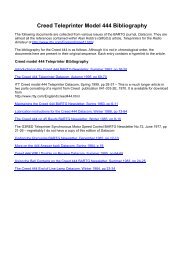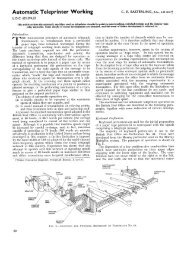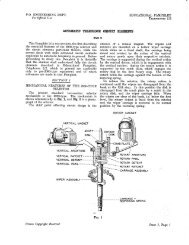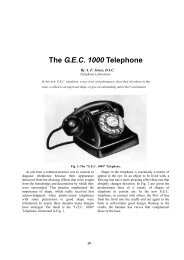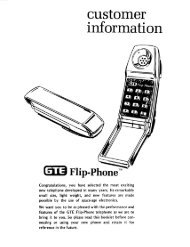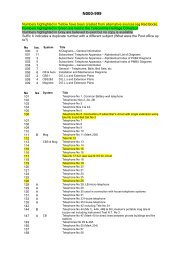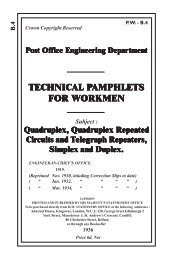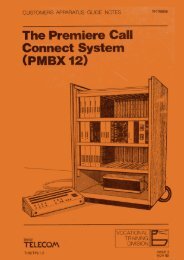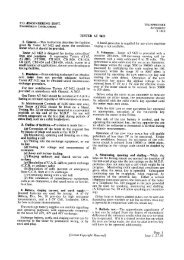TRAFFIC CONTROL TELEPHONE SYSTEMS Circuit - Sam Hallas
TRAFFIC CONTROL TELEPHONE SYSTEMS Circuit - Sam Hallas
TRAFFIC CONTROL TELEPHONE SYSTEMS Circuit - Sam Hallas
Create successful ePaper yourself
Turn your PDF publications into a flip-book with our unique Google optimized e-Paper software.
3. Pawl Spring Tension<br />
3.1 With the armature fully operated the pawl tip shall lie flat on the ratchet<br />
wheel with a pressure of 150 grammes minimum 250 grammes maximum.<br />
(Readjust 160 grammes minimum 240 grammes maximum) measured in the<br />
book of the pawl.<br />
4. Detent<br />
4.1 The tension of the detent spring shall be such that the tip lies flat on the<br />
ratchet wheel with a pressure of 50 grammes minimum, 110 grammes<br />
maximum, measured at the tip. (Readjust 60 grammes minimum 100 grammes<br />
maximum).<br />
4.2 The detent shall be so positioned that the following conditions are met.<br />
With the short face of the ratchet wheel tooth held lightly against the tip of<br />
the detent, the pawl shall drop over the tip of the adjacent tooth when the<br />
armature is electrically operated with a 2 mil feeler inserted between the<br />
armature and core, but shall not do so when operated with an 8 mil feeler<br />
between the armature and core. (Readjust 3 mil and 7 mil feeler gauges).<br />
Check in 4 positions of the rotor. The detent spring shall be clear of the<br />
frame and the tip must overlap the ratchet wheel on both sides.<br />
5. Armature Back Stop<br />
5.1 The armature back stop screw shall be adjusted so that when the armature<br />
is operated by hand and released slowly, the detent will drop over one<br />
tooth of the ratchet wheel, and after stepping, backlash shall not exceed 5<br />
mil at the wiper tips, judged by the eye. In checking this requirement the<br />
rotor should be lightly retarded by hand to prevent overthrow, and the<br />
check should be made in four positions of the rotor. After adjustment<br />
the end of the back stop screw shall be flush or proud of the lock nut.<br />
6. Pawl Stop<br />
6.1 The pawl shall be lightly wedged between the pawl stop and ratchet<br />
wheel, in at least one position of the ratchet wheel. The pawl stop adjustment<br />
shall not prevent the detent spring from dropping into engagement<br />
with the ratchet- wheel teeth. Forward play not to exceed 15 mil at wiper<br />
tips (i.e., ¼ width of contact).<br />
7. Interrupter Contacts<br />
7.1 With the armature normal the buffered spring shall rest on the inner buffer,<br />
and there shall be a clearance between the lever spring and the interrupter<br />
striker.<br />
7.2 With the lever spring in the normal position and the buffered spring in<br />
Page 79



